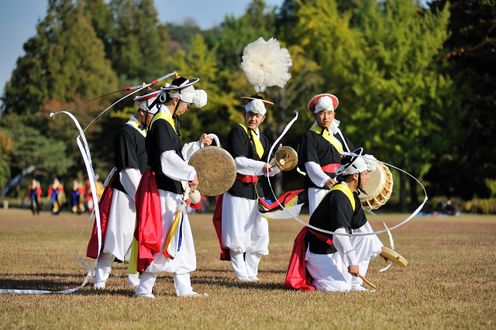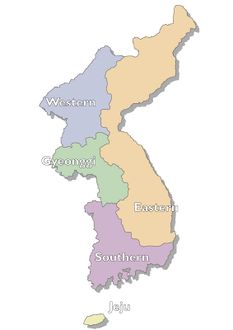Points and Curves - Traditional Korean Music
Traditional Korean music, called gugak – literally “national music” – in Korean, is comprised of four broad genres: court, literati, folk and religious. Court and literati music is based on a concept called yeak sasang, which aimed to create harmony via proper behavior, and therefore was expected to be devoid of any emotion. Folk music was, on the contrary, expressive of both positive and negative emotions and varied widely from region to region. Religious music refers to music played at various shamanistic, Buddhist, or Confucian rituals.
A distinguishing feature of Korean music is its standard use of three-four time, as opposed to two-four or four-four time found in Western, Chinese, or Japanese music. It utilizes variations on a pentatonic scale. Rather than harmonizing with chords, gugak evokes a single melodic line with variations and rhythmic accents to bring out the various instrumental tones. Court, literati, and religious music were unimaginably slow to keep in line with yeak sasang, while folk music could be more expressive and was therefore faster. Folk music, and some literati music, has a strong tradition of improvisation, much like jazz music in the West. Folk music was also a communal experience, with musician and audience interacting throughout the performance.
Some Korean instruments are native to Korea, while others were imported from China with modifications tailored to the vastly different musical tone of Korean music. The most common Korean instruments are the barrel drum (soribuk), hourglass drum (janggu), finger-plucked zither (gayageum), stick-plucked zither (geomungo), silk-string fiddle (haegum), double-reed bamboo instrument (piri), and large bamboo flute (daegeum). The human voice is also an important instrument found in court, religious, and folk music – including folk songs such as Arirang and pansori, a one-man performance of epic story and song. These instruments are played solo (often accompanied by a single drummer) or in small ensembles. Over time, the instruments have changed shape and size to accommodate the needs of musicians as new musical trends emerged. Dance is an also important component of Korean music which served various functions and is found in all musical genres.
Today, gugak is still passed down from teacher to student, with each teacher having their own distinct musical lineage. However, urbanization has led to an amalgamation of once distinct regional styles, while a great deal of Western musical training and influence has led to fusion gugak, which mixes Korean and Western instruments, rhythms, melodies, and performance forms.
Related Articles
- Shamanism
- Buddhism
- Confucianism
- Soribuk
- Janggu
- Gayageum
- Geomungo
- Haegeum
- Piri
- Daegeum
- Pansori
- Arirang
- From Ancient Times to Today - Korea's Native Folk Beliefs
- Honoring Ancestors through Ritual and Music - Ancestral Rituals of the Royal Shrine
- Documenting Ritual and Celebration - The Royal Protocols of the Joseon Dynasty
References
- Academy of Korean Studies. 2010. Cultural Landscapes of Korea. Academy of Korean Studies Press.
- Sheen, Dae Cheol. 2014. “An Invitation to Gugak,Traditional Korean Music.” InfoKorea, 50-63. Academy of Korean Studies Press.






